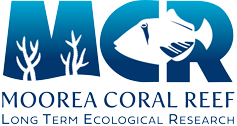Year:
2024
Authors:
Source:
M.S. Thesis
Abstract:
On shallow coral reefs, the fragmentation of habitat into discrete patches has been interpreted as an indicator of impending decline in biological diversity, primarily of corals. In contrast, Rietkerk et al. (2021) hypothesized that habitat fragmentation might prevent ecosystem collapse by allowing organism persistence in spatially heterogeneous environments. This hypothesis expands Island Biogeography Theory (IBT) and has important implications for interpreting the ecological roles of patches on modern reefs but has not been empirically tested in marine environments. In chapter 2, I use patch reefs as a model system and apply the framework of IBT to the shallow reefs of Moorea and St. John, comparing the relationships between habitat structure and diversity both within, and across, the study locations. Here, I test two aspects of the Rietkerk et al. hypothesis, first whether benthic invertebrate diversity increases with the size of patches and their proximity to other patches, and second, that habitat fragmentation maintains coral diversity. I found that larger bommies support higher biological diversity of resident sessile benthic invertebrates, with a steeper relationship exhibited in St. John than in Moorea. I found the relationship between fragmentation in standardized areas of reef in Moorea to be negatively associated with scleractinain diversity, with an opposite relationship in St. John of within-patch fragmentation and diversity of corals. These results suggest a difference in implications of fragmentation at differing spatial scales, and they introduce the possibility that negative feedback can develop between the size of a habitat patch and the ability for the patch to expand to support higher diversity. In chapter 3, I explore the functional consequences of habitat structure by exploring the role of coral colony fission on subsequent coral growth, and the ability for large, structurally complex habitats to confer bleaching resilience to corals. I did not detect an effect of clustering or clonality on nubbins of Porites rus, implying that benefits from clustering or clonality might exhibit size thresholds such that enhanced growth through clustering only occurs when large clusters form in situ. No effect of habitat structure and rugosity on the likelihood of coral bleaching indicates that at the later stages of a bleaching event, where most colonies have experienced bleaching, habitat structure does not provide an amelioration effect from thermal stress. This thesis explores the connection between habitat structure and organism resilience, within the framework of a classic patch ecosystem. I outline connections between the shallow reefs of Moorea and St. John, finding principles of IBT to hold in the context of the patchy shallow reef. In applying contemporary hypotheses that address resilience in heterogenous systems, I find that the continuation of historic resilience in the coral reefs of Moorea and St. John will depend on the ability for habitat structure to support diverse ecosystems and is more likely to be supported if large and unfragmented reefs can continue to grow.
Publication Type:
Thesis or Dissertation
Publisher:
Department of Biology, CSU Northridge



